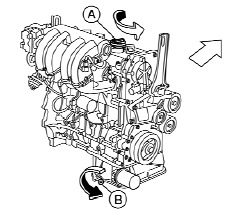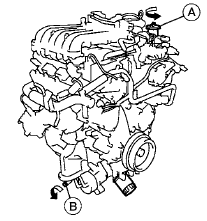Changing engine oil

QR25DE

VQ35DE
1. Park the vehicle on a level surface and apply the parking brake.
2. Start the engine and let it idle until it reaches operating temperature, then turn it off.
3. Remove the oil filler A cap by turning it counterclockwise.
4. Place a large drain pan under the drain plug B .
5. Remove the drain plug B with a wrench by turning it counterclockwise and completely drain the oil.
If the oil filter is to be changed, remove and replace it at this time. See “Changing engine oil filter” in this section.
● Waste oil must be disposed of properly.
● Check your local regulations.
WARNING
● Prolonged and repeated contact with used engine oil may cause skin cancer.
● Try to avoid direct skin contact with used oil. If skin contact is made, wash thoroughly with soap or hand cleaner as soon as possible.
● Keep used engine oil out of reach of children.
CAUTION
Be careful not to burn yourself. The engine oil may be hot.
6. Clean and reinstall the drain plug and a new washer. Securely tighten the drain plug with a wrench. Do not use excessive force. Drain plug tightening torque:
22 - 29 ft-lb (29 - 39 N·m)
7. Refill engine with recommended oil through the oil filler opening, then install the oil filler cap securely.
See “Capacities and recommended fuel/lubricants” in the “Technical and consumer information” section of this manual for drain and refill capacity.
The drain and refill capacity depends on the oil temperature and drain time. Use these specifications for reference only. Always use the dipstick to determine when the proper amount of oil is in the engine.
8. Start the engine. Check for leakage around the drain plug and oil filter. Correct as required.
9. Turn the engine off and wait more than 10 minutes. Check the oil level with the dipstick. Add engine oil if necessary.
See also:
Locking with key
Locking with key
The power door lock system allows you to lock
or unlock all doors simultaneously.
- Turning the driver’s door key cylinder to the
front of the vehicle 1 will lock all doors ...
Rear Control Cancel Switch (if so equipped)
The rear control cancel switch operates when the
ignition switch is placed in the ACC or ON position.
The rear control cancel switch is located on the
left side of the instrument panel.
Pushin ...
Comfort Levels
I remember finding our 2009 Cube 1.8 S' driver's seat rather uncomfortable.
The 2010's seemed better, though it doesn't appear to be different, aside from
the fabric. Another editor, who took the ...
